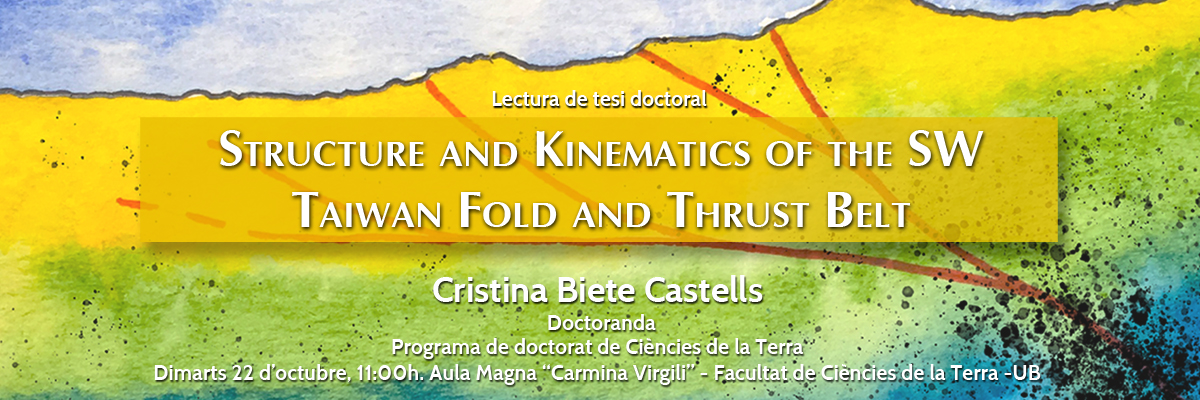
Details
- Thesis title: Structure and Kinematics of the SW Taiwan fold and thrust belt
- Author: Cristina Biete Castells
- Date: October, 22nd, 2019; 11:00h
- Place: Aula Magna “Carmina Virgili” Facultat de Ciències de la Terra (UB)
Thesis supervisors
- Dra. Joaquina Álvarez-Marrón (ICTJA-CSIC)
- Dr. Dennis Brown (ICTJA-CSIC)
Abstract
Studies of mountain belts worldwide show that along-strike changes are common in their foreland fold-and-thrust belts. These are typically caused by processes related to fault reactivation and/or fault focusing along changes in sedimentary sequences. The study of active orogens, such as Taiwan, can provide insights into how these processes influence transient features such as seismicity, contemporaneous stress and strain fields and topography. In Taiwan, the fold-and-thrust belt comprises a roughly N-S striking, west verging imbricate thrust system that has been developing since the Late Miocene. This fold-and-thrust belt is deforming the sediments from the outer shelf to the base of the slope of the Eurasian continental margin, incorporating structural (e.g., necking zone, extensional fault system, failed rift) and morphological (e.g., the shelf, shelf/slope break, the slope) features of the margin. In this thesis, we adopt a multidisciplinary approach in order to test the hypothesis of whether or not the inherited structural and morphological architecture of the Eurasian continental margin may be influencing the development of the south central Taiwan fold-and-thrust belt.
We first trace regional-scale features from the outer shelf to the slope base of the Eurasian continental margin in the Taiwan Strait into the south central Taiwan fold-and-thrust belt. We then present a regional-scale new surface geological mapping that we combine with P-wave velocity maps and sections, seismicity, and topography data to test the hypothesis in a regional-scale to investigate causal links between these features of the fold-and-thrust belt and those from the margin. We further test the hypothesis in regional-scale to see whether or not structural and morphological features inherited from the margin are affecting the contemporaneous stress and strain fields in south central Taiwan.
The principal stress directions are estimated from the inversion of clustered earthquake focal mechanisms and the direction of maximum compressive horizontal stress (SH) is calculated throughout the study area. From these data the most likely fault plane orientations and their kinematics are inferred. The directions of displacement, compressional strain rate, and maximum shear strain rate derived from GPS data are also calculated and plotted. These are discussed together with the stress inversion results. Finally, the structure of the area in southwest Taiwan fold-and-thrust belt corresponding to the necking zone is investigated in more detail. We define its structure, presenting new surface geological mapping from which we construct balanced and restored cross-sections and along-strike sections.
From these we compile maps of the basal thrust, thrust branch lines and, where possible, stratigraphic cut-offs. These data show that the most important along-strike change takes place at the eastward prolongation of the upper part of the margin necking zone, where there is an interpreted link between fault reactivation, involvement of basement in the thrusting, concentration of seismicity, and the formation of high topography. The contemporaneous stress and strain fields also show a marked change across the upper part of the margin necking zone. The direction of SH changes from north to south across the study area (≈ 8.3 cm/yr toward 306°), with the direction of SH remaining roughly sub-parallel to the relative plate motion vector in the north, whereas in the south it rotates nearly 45° counter-clockwise. The direction of horizontal maximum compression strain rate and associated maximum shear planes, together with the displacement field display an overall similar pattern between them, although undergoing a less marked rotation. In the southwest Taiwan fold-and-thrust belt, in the area corresponding to the margin necking zone, the detailed 3D structural analysis shows a less marked but still important along-strike change in the structure than that described for the upper part of the necking zone. This change takes place across a transverse zone that is composed of a suite of structures at the surface that we call the Hsinhua transverse zone. We suggest that this transverse zone coincides with variations in the geometry of the basal thrust which, in turn, has a causal relationship to (possibly fault bounded) basement highs and lows that are inherited from the continental margin.
We interpret all these along-strike changes in the fold-and-thrust belt to be related to the reactivation of east-northeast striking faults inherited from the rifted Eurasian margin. In the upper part of the margin necking zone, the strike-slip reactivation of east-northeast striking extensional faults is causing sigmoidal offset of structures and topographic ridges, and the rotation of the SH and H directions, together with that of the horizontal displacement field. In the necking zone, the reactivation of east-northeast striking faults is also influencing the development of the fold-and-thrust belt, although with a less marked effect.
More information
- Biete, C., Brown, D., Lund, B., Alvarez-Marron, J., Wu, Y.-M., Kuo-Chen, H., & Ho, C.-W. (2019). The influence of inherited continental margin structures on the stress and strain fields of the south-central Taiwan fold-and-thrust belt. Geophysical Journal International Volume 219, Issue 1, October 2019, Pages 430–448, https://doi.org/10.1093/gji/ggz296
- Biete, C., Alvarez‐Marron, J., Brown, D., & Kuo‐Chen, H. ( 2018). The structure of southwest Taiwan: The development of a fold‐and‐thrust belt on a margins outer shelf and slope. Tectonics, 37, 1973– 1993. https://doi.org/10.1029/2017TC004910
- Brown, D., J. Alvarez-Marron, C. Biete, H. Kuo-Chen, G. Camanni, and C.-W. Ho (2017), How the structural architecture of the Eurasian continental margin affects the structure, seismicity, and topography of the south central Taiwan fold-and-thrust belt, Tectonics, 36(7), 1275-1294, doi: 10.1002/2017TC004475.
